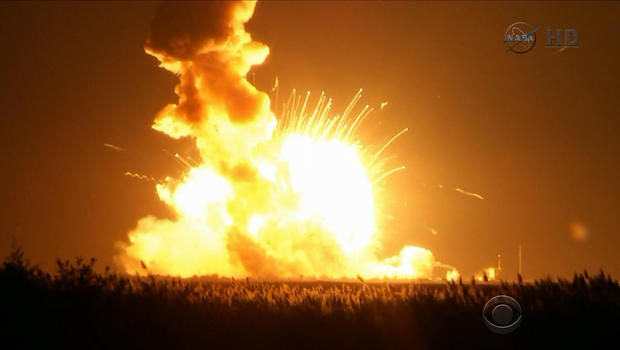Orbital Sciences rocket explodes moments after launch
WALLOPS ISLAND, Va. -- An Orbital Sciences Antares rocket carrying an unmanned cargo craft bound for the International Space Station exploded into flames Tuesday evening moments after launch at NASA's Mid-Atlantic Regional Spaceport in Wallops Island, Virginia.
The countdown had seemed routine and the rocket lifted off as scheduled at 6:22 p.m. EDT, but then burst into a fireball seconds later. The debris crashed down on the launching pad, spreading fiery wreckage around the area.
NASA said all personnel are accounted for and no one was injured.
This was the first catastrophic launch failure since NASA began its commercial spaceflight effort.
The rocket was constructed by Orbital Sciences Corp., which contracts with NASA to supply the ISS. A statement from Orbital said the company has formed an "anomaly investigation board" which will work with government agencies on a probe into the explosion.
"As we begin to gather information, our primary concern lies with the ongoing safety and security of those involved in our response and recovery operations," said Frank Culbertson, Orbital's Executive Vice President. "We will conduct a thorough investigation immediately to determine the cause of this failure and what steps can be taken to avoid a repeat of this incident."
At a press conference held a few hours after the explosion, Culbertson said crews will begin to piece together what went wrong at daybreak.
"We don't have any early indication of exactly what might have failed but we need some time to take a look at that," he said. All of the damage on the ground seemed to be confined to the launch pad area, but that will also be determined later.
William Gerstenmaier, Associate Administrator of NASA's Human Exploration and Operations Directorate, said at the press conference that the crew aboard the International Space Station was in no danger and had enough resources to last them considerably.
"What's important is that we understand what happened, and that we fix it with some confidence," he said. "I think we'll learn from this and this will be valuable to us as we move forward."
In a statement, NASA said it plans to continue launches to the ISS.
"We will continue to move forward toward the next attempt once we fully understand today's mishap," the statement read.
The rocket was carrying a Cygnus cargo ship loaded with gear for the six crew members living on the space station. NASA said the cargo also included "classified crypto equipment."
"This mission is going to carry over 5,000 pounds of cargo to the crew, a wide variety of items, everything from science to clothes to food, tools, replacement parts, etc.," Culbertson, a former shuttle commander and space station crew member, said before the launch went bad.
NASA said that in the near term, space station operations will not be impacted by the loss of the cargo ship. It said the Cygnus craft was also carrying science experiments that were destroyed in the crash.
CBS News space correspondent Bill Harwood reported that it was not clear watching video replays of the launching what might have gone wrong, whether it involved one or both Aerojet Rocketdyne AJ26 first stage engines or some other system or even whether the rocket's self-destruct system was activated.
An AJ26 engine being test fired last May for an Antares flight next year suffered a catastrophic failure 30 seconds into a planned 54-second burn. After a detailed failure investigation, Orbital managers cleared the powerplants for use in downstream missions based on corrective actions implemented in the wake of the failure.
Whether a similar problem developed during Tuesday's launching is not yet known.
In any case, the loss was a major setback for Orbital's plans to establish routine space station resupply missions under a $1.9 billion contract with NASA calling for delivery of 20 tons of hardware over at least eight flights through 2016.
It also marked a major setback for the space station program, which is attempting to fill in the void left by the space shuttle's retirement, using commercially developed cargo ships to carry supplies and equipment once carried by the manned orbiter.
The mission would have been Orbital's third operational space station resupply flight -- the fourth including a demonstration mission -- under a $1.9 billion contract with NASA. Orbital Sciences made its first flight to the ISS just over a year ago, lifting off on Sept. 18, 2013.
SpaceX holds a similar $1.6 billion contract covering 12 resupply missions. SpaceX's Falcon 9 rocket and Dragon cargo ship remain operational, with the next two resupply flights planned for December and February.
The launch date had originally been set for Monday, but a boat in the vicinity caused officials to scrub it at the a last minute and reschedule for Tuesday. If the launch had been successful it would have been visible along the United States' eastern seaboard.
This is a developing story and will be updated.
